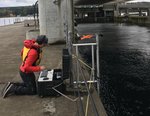A recently completed study at the Hood Canal Bridge has found that about half of juvenile steelhead trout aren’t able to pass under the bridge as the young fish migrate out to sea.
The …
This item is available in full to subscribers.
We have recently launched a new and improved website. To continue reading, you will need to either log into your subscriber account, or purchase a new subscription.
If you had an active account on our previous website, then you have an account here. Simply reset your password to regain access to your account.
If you did not have an account on our previous website, but are a current print subscriber, click here to set up your website account.
Otherwise, click here to view your options for subscribing.
* Having trouble? Call our circulation department at 360-385-2900, or email our support.
Please log in to continue |
|

A recently completed study at the Hood Canal Bridge has found that about half of juvenile steelhead trout aren’t able to pass under the bridge as the young fish migrate out to sea.
The findings are the result of a collaboration between multiple private, state and tribal organizations, and orchestrated by Long Live the Kings, a nonprofit that focuses on the restoration of wild salmon and sustainable fishing in the Pacific Northwest.
A report from the group summarizing the results of the six-year-long study detailed the threat by the bridge to local fish populations, in particular, steelhead trout. Some segments of the steelhead population are listed as threatened or endangered under the Endangered Species Act.
“We see a huge opportunity to save our state fish, steelhead are not only beautiful but they are culturally prized by Washingtonians and tribes,” said Lucas Hall, senior project manager for Long Live the Kings. “It’s important that we shine a spotlight on this issue and get it the attention it needs.”
Although a bridge has spanned Hood Canal for more than 50 years, little study has been done, until recently, on the structure’s impact to native fish, including ocean-bound salmon as well as steelhead trout.
“When the Hood Canal Bridge opened to traffic in 1961, nobody knew that the unique floating structure would become a trap of sorts for untold numbers of young salmon and steelhead,” the study noted. “Scientific studies have shown that the bridge also impedes the migration of juvenile steelhead — and affects Chinook and chum salmon as well.”
Juvenile salmon and steelhead coming from tributaries and streams flowing into Hood Canal make their way to the canal and head north toward the Strait of Juan de Fuca.
When they arrive at the bridge, only about half of the juvenile steelhead actually manage to make it to the other side.
The reason for steelhead in particular becoming stuck at the bridge comes from the fact that they typically swim near the surface of the water.
When the fish encounter the 15-foot-deep concrete pontoons upon which the bridge’s columns and roadway are built, they can become stuck, confused or a snack to marine mammals. The pontoons have also created a sort of buffet for predators like harbor seals and sea lions that have learned to use the migratory obstacle to their advantage.
Hall said the matter of handling the predators is a rather sticky subject.
“Our tools are really limited; it’s very difficult to reduce predation,” Hall said, noting that organizers had instead opted to focus their efforts on trying to decrease the amount of time fish spend at the bridge.
“We identified some areas on the bridge where we think fish are having special difficulties there.”
Areas that have been observed to block or delay steelhead, Hall explained, could possibly receive fixes to help coerce the steelhead to move along once they hit the bridge.
Implementing the solution would require the organizers to cut a few corners — literally.
A chokepoint for steelhead comes when the fish inadvertently get turned around following the 90-degree corners of the concrete pontoon sections, according to the study.
Experts have observed the fish apparently following the walls of the pontoons when they become confused. Organizers with the project believe that eliminating the inside corners on the bridge pontoons could help the fish navigate to open water.
By smoothing out those 90-degree corners, experts note, the fish will be more likely to continue onto areas of the bridge that are passable.
Rounding of outside corners by installing eddy-reduction structures called bullnoses would also help to reduce the eddies that can turn fish around.
It is also believed that more-frequent bridge openings could see a higher number of fish passing through the open bridge span during times of trout and salmon migrations.
According to Hall, Long Live the Kings would like to get these initial measures in place by 2022, but the only way that is going to happen is if the state can find the $2.5 million necessary for the improvements during its biennial budgeting process.
Given the current economic outlook, Hall admitted, it doesn’t look too good.
Also included as part of potential funding would be further study of the Chinook and chum populations and how the bridge may be affecting their migrations.
Hall explained that the sheer volume of fish and the tools currently available to his team limited the scope of the study mainly to steelhead.
“We do see Chinook and chum smolts pass the bridge, gathering in huge magnitudes, at least thousands, maybe hundreds of thousands,” Hall said. “The trouble is it just becomes a logistical concern for us to put a number on the mortality.”
“We do know they are being impacted by the bridge, but we can’t describe what that impact is,” he said.